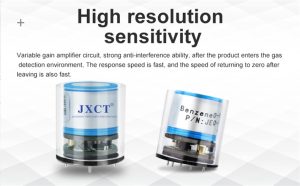Air pollution has become a pressing global concern, posing significant risks to human health and the environment. To effectively address this issue, accurate and reliable air quality monitoring is crucial. Gas sensor technology has emerged as a critical tool in monitoring and analyzing air pollutants. In this article, we will explore the importance of gas sensor technology in air quality monitoring, its applications, advancements, and future prospects.

Understanding Gas Sensor Technology:
a. Principle of Operation: Gas sensors work based on various detection principles, including electrochemical, semiconductor, optical, and solid-state technologies. These sensors detect and measure different gases and their concentrations present in the ambient air.
b. Gas Detection Range:
Gas sensors are designed to detect a wide range of pollutants, including volatile organic compounds (VOCs), nitrogen dioxide (NO2), carbon monoxide (CO), ozone (O3), sulfur dioxide (SO2), and particulate matter (PM). Each sensor is specifically calibrated to detect and quantify particular gases or particles.
c. Sensor Accuracy and Sensitivity:
The accuracy and sensitivity of gas sensors are critical for reliable monitoring of air quality. Advances in sensor technology have significantly improved the precision and sensitivity of gas sensors, allowing for more precise and real-time measurements.
Applications of Gas Sensor Technology in Air Quality Monitoring: a. Urban Air Quality Assessment: Gas sensors are utilized in urban areas to measure and monitor air pollutants emitted from vehicular traffic, industrial activities, and residential sources. Continuous monitoring helps identify high-risk areas and develop targeted mitigation strategies.
b. Indoor Air Quality Monitoring:
Indoor air quality can be adversely affected by various factors such as inadequate ventilation, cooking emissions, and off-gassing from building materials. Gas sensors enable continuous monitoring, helping to identify pollutants and maintain healthy indoor environments.
c. Industrial Emissions Control:
Gas sensors play a vital role in monitoring emissions from industrial processes. By detecting and quantifying pollutants in real-time, these sensors facilitate compliance with environmental regulations, improve process efficiency, and minimize the impact on air quality.
d. Environmental Impact Assessments:
During environmental impact assessments, gas sensors are deployed to measure air pollutants released during construction activities or industrial projects. These sensors help assess and mitigate potential impacts on local air quality and nearby communities.
e. Personal Air Quality Monitoring:
The miniaturization of gas sensors has led to the development of wearable or portable devices that enable individuals to monitor their personal exposure to air pollutants. Such devices can provide real-time data, empowering individuals to make informed decisions about their daily activities.
Advancements in Gas Sensor Technology: a. Miniaturization and Portability: Gas sensors have become smaller and more portable, enabling easy integration into various monitoring systems. This advancement allows for flexible deployment, including wearable devices, drones, and sensor networks.
b. Selectivity and Specificity: Ongoing research aims to enhance the selectivity and specificity of gas sensors to accurately identify and measure individual pollutants, even in complex atmospheric conditions. This specificity ensures reliable and accurate monitoring results.
c. Wireless Connectivity and IoT Integration: Gas sensors can now be incorporated into wireless networks and Internet of Things (IoT) platforms. This integration enables real-time data transmission, remote monitoring, and data analysis, improving the efficiency and effectiveness of air quality management.
d. Data Analysis and Artificial Intelligence: With the increasing volume of data generated by gas sensors, effective data analysis and interpretation become critical. Advanced algorithms and artificial intelligence techniques are employed to analyze large datasets and extract meaningful insights for decision-making.

Future Prospects and Challenges: a. Improved Sensor Performance: Researchers are continuously working towards enhancing sensor performance, including increased sensitivity, reduced power consumption, and improved stability. These advancements will lead to more accurate and reliable air quality monitoring systems.
b. Multi-Gas Sensor Integration: Integrating multiple gas sensors into a single device or system allows for comprehensive monitoring of various pollutants simultaneously. This integration enhances data collection and analysis, providing a more holistic view of overall air quality.
c. Real-time Air Quality Mapping: The integration of gas sensors with geographic information systems (GIS) is expected to enable real-time air quality mapping on a broader scale. This advancement will provide policymakers and st
 : +86 155 8830 2704
: +86 155 8830 2704 : jxdziot@gmail.com
: jxdziot@gmail.com
